Real-Time Prediction of Rheological Properties of Invert Emulsion Mud Using Adaptive Neuro-Fuzzy Inference System
Abstract
1. Introduction
1.1. Mud Properties Measurements
1.2. Applications of Artificial Intelligence in the Petroleum Industry
1.3. Adaptive Neuro-Fuzzy Inference System (ANFIS)
2. Materials and Methods
2.1. Data Statistics
2.2. Methodology and Building ANFIS Models
3. Results
4. Discussion
Predicted R300 and R600 for calculating PV and AV for Comparison with Previous Studies
5. Conclusions
- ANFIS models were able to predict the rheological properties with high accuracy based on MWT and MFV only
- The ANFIS models predict the rheology of the invert emulsion mud system with an AAPE less than 4% and a correlation coefficient higher than 90% for all prediction models for the training and testing data sets.
- Using the predicted values for viscometer readings at 600 and 300 rpm to calculate the apparent and plastic viscosity is showing great accuracy for the calculated AV and PV.
- The ANFIS model outperformed the other AV correlations in the literature.
- The model results will help the drilling engineers to have better control over the hole cleaning parameters and monitor the drilling fluid rheology in real-time.
Author Contributions
Funding
Acknowledgments
Conflicts of Interest
Nomenclature
| AV | Apparent viscosity (cP) |
| PV | Plastic viscosity (cP) |
| YP | Yield point (1b/100 ft2) |
| R300 | Dial reading at 300 revolutions per minute (deg) |
| R600 | Dial reading at 600 revolutions per minute (deg) |
| MFV | Marsh funnel time (s) |
| MWT | Mud weight (pcf) |
| AAPE | Average absolute percentage error |
| R | Correlation coefficient |
| n | Flow behavior index |
| cP | Centipoise |
| Pa.s | Pascal.second |
| rpm | Revolution Per Min |
| lb | Pound mass |
| AI | Artificial Intelligence |
Unit Conversion
| cP | = 0.001 Pa.s |
| Lb/ 100 f2 | = 0.4788 Pa |
| inch | = 2.54 cm |
| pcf | = 0.016 gm/cm3 |
References
- Knox, D.; Jiang, P. Drilling further with water-based fluids-selecting the right lubricant. In Proceedings of the SPE International Symposium on Oilfield Chemistry; The Woodlands, TX, USA, 2–4 February 2005, SPE-92002-MS; Society of Petroleum Engineers: The Woodlands, TX, USA, 2005. [Google Scholar]
- Bleier, R. Selecting a drilling fluid. J. Pet. Technol. 1990, 42, 832–834. [Google Scholar] [CrossRef]
- Caenn, R.; Darley, H.C.H.; Gray, G.R. Composition and Properties of Drilling and Completion Fluids, 6th ed.; Gulf Professional Publishing; Elsevier: Waltham, MA, USA, 2011. [Google Scholar]
- Power, D.; Zamora, M. Drilling fluid yield stress: Measurement techniques for improved understanding of critical drilling fluid parameters. In Proceedings of the AADE National Technology Conference Practical Solutions for Drilling Challenges, Radisson Astrodome Houston, TX, USA, 1 April 2003. [Google Scholar]
- Brandt, G.W.; Weintritt, D.J.; Gray, G.R. An Improved Water-in-Oil Emulsion Mud. J. Pet. Technol. 1960, 12, 14–17. [Google Scholar] [CrossRef]
- Gray, G.R.; Grioni, S. Varied Applications of Invert Emulsion Muds. Soc. Pet. Eng. 1969. [Google Scholar] [CrossRef]
- Growcock, F.B.; Ellis, C.F.; Schmidt, D.D.; Azar, J.J. Electrical Stability, Emulsion Stability, and Wettability of Invert Oil-Based Muds. Soc. Pet. Eng. 1994. [Google Scholar] [CrossRef]
- Ramasamy, J.; Amanullah, M. Converting Waste Vegetable Oil to Emulsifier for Invert-Emulsion Oil Based Mud. Int. Pet. Technol. Conf. 2019. [Google Scholar] [CrossRef]
- Amani, M.; Al-Jubouri, M.; Shadravan, A. Comparative study of using oil-based mud versus water-based mud in HPHT fields. Adv. Pet. Explor. Dev. 2012, 4, 18–27. [Google Scholar]
- Hossain, M.E.; Al-Majed, A.A. Fundamentals of Sustainable Drilling Engineering; Scrivener Publishing LLC: Beverly, MA, USA, 2015. [Google Scholar]
- Lee, J.; Shadravan, A.; Young, S. Rheological Properties of Invert Emulsion Drilling Fluid under Extreme HPHT Conditions. In Proceedings of the IADC/SPE Drilling Conference and Exhibition, San Diego, CA, USA, 6–8 March 2012. [Google Scholar]
- Marsh, H. Properties and treatment of rotary mud. Trans. AIME 1931, 92, 234–251. [Google Scholar] [CrossRef]
- Balhoff, M.T.; Lake, L.W.; Bommer, P.M.; Lewis, R.E.; Weber, M.J.; Calderin, J.M. Rheological and yield stress measurements of non-Newtonian fluids using a Marsh Funnel. J. Pet. Sci. Eng. 2011, 77, 393–402. [Google Scholar] [CrossRef]
- Elkatatny, S.; Fadhel, R.; Mheibesh, Y. Automated March Funnel for Oil and Gas Field Operations. U.S. Patent Application 16,384,241, 24 October 2019. [Google Scholar]
- Saasen, A.; Omland, T.H.; Ekrene, S.; Brévière, J.; Villard, E.; Kaageson-Loe, N.; Tehrani, A.; Cameron, J.; Freeman, M.A.; Growcock, F.; et al. Automatic measurement of drilling fluid and drill-cuttings properties. SPE Drill. Completion 2009, 24, 611–625. [Google Scholar] [CrossRef]
- Taugbøl, K.; Brevik, J.O.; Rudshaug, B. Automatic Drilling Fluid Measurements. In Proceedings of the SPE Russian Petroleum Technology Conference, Moscow, Russia, 22–24 October 2019. [Google Scholar] [CrossRef]
- Vajargah, A.K.; Sullivan, G.; Oort, E.V. Automated fluid rheology and ECD management. In Proceedings of the SPE Deepwater Drilling and Completions Conference, Galveston, TX, USA, 14–15 September 2016. [Google Scholar] [CrossRef]
- Broussard, S.; Gonzalez, P.; Murphy, R.J.; Marvel, C. Making Real Time Fluid Decisions with Real Time Fluid Data at the Rig Site: Results of Automated Drilling Fluid Measurement Field Trials. In Abu Dhabi International Petroleum Exhibition and Conference; Society of Petroleum Engineers: Houston, TX, USA, 2010. [Google Scholar]
- Nagy, K.; Hajrizi, E. Beyond the Age of Oil and Gas–How artificial intelligence is transforming the energy portfolio of the societies. IFAC-PapersOnLine 2018, 51, 308–310. [Google Scholar] [CrossRef]
- Agwu, O.E.; Akpabio, J.U.; Alabi, S.B.; Dosunmu, A. Artificial intelligence techniques and their applications in drilling fluid engineering: A review. J. Pet. Sci. Eng. 2018, 167, 300–315. [Google Scholar] [CrossRef]
- Barbosa, L.F.F.; Nascimento, A.; Mathias, M.H.; de Carvalho, J.A., Jr. Machine learning methods applied to drilling rate of penetration prediction and optimization-A review. J. Pet. Sci. Eng. 2019, 183, 106332. [Google Scholar] [CrossRef]
- Lim, J.S.; Kim, J. Reservoir porosity and permeability estimation from well logs using fuzzy logic and neural networks. In Proceedings of the SPE Asia Pacific Oil and Gas Conference and Exhibition; Perth, Australia, 18–20 October 2004, Society of Petroleum Engineers: Houston, TX, USA, 2004. [Google Scholar]
- Elkatatny, S.; Tariq, Z.; Mahmoud, M.; Abdulraheem, A. New insights into porosity determination using artificial intelligence techniques for carbonate reservoirs. Petroleum 2018, 4, 408–418. [Google Scholar] [CrossRef]
- Moussa, T.; Elkatatny, S.; Mahmoud, M.; Abdulraheem, A. Development of new permeability formulation from well log data using artificial intelligence approaches. J. Energy Resour. Technol. 2018, 140, 072903. [Google Scholar] [CrossRef]
- Mahmoud, M.; Elkatatny, S.; Ramadan, E.; Abdulraheem, A. Development of lithology-based static Young’s modulus correlations from log data based on data clustering technique. J. Pet. Sci. Eng. 2016, 146, 10–20. [Google Scholar] [CrossRef]
- Elkatatny, S.M.; Zeeshan, T.; Mahmoud, M.; Abdulazeez, A.; Mohamed, I.M. Application of Artificial Intelligent Techniques to Determine Sonic Time from Well Logs. In Proceedings of the U.S. Rock Mechanics/Geomechanics Symposium, Houston, TX, USA, 26–29 June 2016. [Google Scholar]
- Kamel, M.A.; Elkatatny, S.; Mysorewala, M.F.; Al-Majed, A.; Elshafei, M. Adaptive and real-time optimal control of stick–slip and bit wear in autonomous rotary steerable drilling. J. Energy Resour. Technol. 2018, 140, 032908. [Google Scholar] [CrossRef]
- Elkatatny, S.M.; Tariq, Z.; Mahmoud, M.A.; Al-AbdulJabbar, A. Optimization of rate of penetration using artificial intelligent techniques. In Proceedings of the Rock Mechanics/Geomechanics Symposium, San Francisco, CA, USA, 25–28 June 2017. [Google Scholar]
- Al-AbdulJabbar, A.; Elkatatny, S.; Mahmoud, M.; Abdelgawad, K.; Al-Majed, A. A Robust Rate of Penetration Model for Carbonate Formation. J. Energy Resour. Technol. 2019, 141, 042903. [Google Scholar] [CrossRef]
- Tariq, Z.; Elkatatny, S.; Mahmoud, M.; Ali, A.Z.; Abdulraheem, A. A new technique to develop rock strength correlation using artificial intelligence tools. In Proceedings of the SPE Reservoir Characterisation and Simulation Conference and Exhibition, Abu Dhabi, UAE, 8–10 May 2017. [Google Scholar] [CrossRef]
- Tariq, Z.; Elkatatny, S.; Mahmoud, M.; Ali, A.Z.; Abdulraheem, A. A new approach to predict failure parameters of carbonate rocks using artificial intelligence tools. In Proceedings of the SPE Kingdom of Saudi Arabia Annual Technical Symposium and Exhibition, Dammam, Saudi Arabia, 24–27 April 2017. [Google Scholar] [CrossRef]
- Tariq, Z.; Elkatatny, S.M.; Mahmoud, M.A.; Abdulraheem, A.; Abdelwahab, A.Z.; Woldeamanuel, M.; Mohamed, I.M. Development of new correlation of unconfined compressive strength for carbonate reservoir using artificial intelligence techniques. In Proceedings of the Rock Mechanics/Geomechanics Symposium, San Francisco, CA, USA, 25–28 June 2017. [Google Scholar]
- Tariq, Z.; Elkatatny, S.M.; Mahmoud, M.A.; Abdulraheem, A.; Abdelwahab, A.Z.; Woldeamanuel, M. Estimation of rock mechanical parameters using artificial intelligence tools. In Proceedings of the Rock Mechanics/Geomechanics Symposium, San Francisco, CA, USA, 25–28 June 2017. [Google Scholar]
- Elkatatny, S. Application of Artificial Intelligence Techniques to Estimate the Static Poisson’s Ratio Based on Wireline Log Data. J. Energy Resour. Technol. 2018, 140, 072905. [Google Scholar] [CrossRef]
- Elkatatny, S.; Tariq, Z.; Mahmoud, M.; Mohamed, I.; Abdulraheem, A. Development of new mathematical model for compressional and shear sonic times from wireline log data using artificial intelligence neural networks (white box). Arab. J. Sci. Eng. 2018, 43, 6375–6389. [Google Scholar] [CrossRef]
- Elkatatny, S.; Mahmoud, M.; Mohamed, I.; Abdulraheem, A. Development of a new correlation to determine the static Young’s modulus. J. Pet. Explor. Prod. Technol. 2018, 8, 17–30. [Google Scholar] [CrossRef]
- Elkatatny, S.; Gomaa, I.; Moussa, T. New approach to obtain the rheological properties of drill-in fluid on a real-time using artificial intelligence. Petroleum 2019. [Google Scholar] [CrossRef]
- Pitt, M.J. The Marsh funnel and drilling fluid viscosity: A new equation for field use. SPE Drill. Completion 2000, 15, 3–6. [Google Scholar] [CrossRef]
- Almahdawi, F.H.; Al-Yaseri, A.Z.; Jasim, N. Apparent viscosity direct from Marsh funnel test. Iraqi J. Chem. Pet. Eng. 2014, 15, 51–57. [Google Scholar]
- Razi, M.M.; Mazidi, M.; Razi, F.M.; Aligolzadeh, H.; Niazi, S. Artificial neural network modeling of plastic viscosity, yield point, and apparent viscosity for water-based drilling fluids. J. Dispers. Sci. Technol. 2013, 34, 822–827. [Google Scholar] [CrossRef]
- Elkatatny, S.; Mousa, T.; Mahmoud, M. A New Approach to Determine the Rheology Parameters for Water-Based Drilling Fluid Using Artificial Neural Network. In Proceedings of the SPE Kingdom of Saudi Arabia Annual Technical Symposium and Exhibition; Dammam, Saudi Arabia, 23–26 April 2018, Society of Petroleum Engineers: Houston, TX, USA, 2018. [Google Scholar]
- Elkatatny, S.; Tariq, Z.; Mahmoud, M. Real Time Prediction of Drilling Fluid Rheological Properties Using Artificial Neural Networks Visible Mathematical Model (White Box). J. Pet. Sci. Eng. 2016, 146, 1202–1210. [Google Scholar] [CrossRef]
- Elkatatny, S. Real-time prediction of rheological parameters of KCL water-based drilling fluid using artificial neural networks. Arab. J. Sci. Eng. 2017, 42, 1655–1665. [Google Scholar] [CrossRef]
- Da Silva Bispo, V.D.; Scheid, C.M.; Calçada, L.A.; da Cruz Meleiro, L.A. Development of an ANN-based soft-sensor to estimate the apparent viscosity of water-based drilling fluids. J. Pet. Sci. Eng. 2017, 150, 69–73. [Google Scholar] [CrossRef]
- Al-Azani, K.; Elkatatny, S.; Abdulraheem, A.; Mahmoud, M.; Al-Shehri, D. Real Time Prediction of the Rheological Properties of Oil-Based Drilling Fluids Using Artificial Neural Networks. In Proceedings of the SPE Kingdom of Saudi Arabia Annual Technical Symposium and Exhibition, Dammam, Saudi Arabia, 23–26 April 2018. [Google Scholar] [CrossRef]
- Elzenary, M.; Elkatatny, S.; Abdelgawad, K.Z.; Abdulraheem, A.; Mahmoud, M.; Al-Shehri, D. New Technology to Evaluate Equivalent Circulating Density While Drilling Using Artificial Intelligence. In Proceedings of the SPE Kingdom of Saudi Arabia Annual Technical Symposium and Exhibition, Dammam, Saudi Arabia, 23–26 April 2018. [Google Scholar] [CrossRef]
- Hoang, M. Tuning of viscosity and density of non-Newtonian fluids through mixing process using multimodal sensors. Master’s Thesis, University College of Southeast Norway, Porsgrunn, Norway, 2016. [Google Scholar]
- Gowida, A.; Elkatatny, S.; Ramadan, E.; Abdulraheem, A. Data-Driven Framework to Predict the Rheological Properties of CaCl2 Brine-Based Drill-in Fluid Using Artificial Neural Network. Energies 2019, 12, 1880. [Google Scholar] [CrossRef]
- Chilingarian, G.V.; Alp, E.; Al-Salem, M.; Uslu, S.; Gonzales, S.; Dorovi, R.J. Drilling Fluid Evaluation Using Yield Point-Plastic Viscosity Correlation. Energy Sources 1983, 8, 233–244. [Google Scholar] [CrossRef]
- Jenkins, P.B.; Crockford, A.L. Drilling Costs. In Proceedings of the SPE European Spring Meeting, London, UK, 14–15 April 1975. [Google Scholar] [CrossRef]
- Okoro, E.E.; Dosunmu, A.; Iyuke, S.E. Data on Cost analysis of drilling mud displacement during drilling operation. Data Brief 2018, 19, 535–541. [Google Scholar] [CrossRef]
- Mitchell, R.F.; Miska, S.Z. Fundamentals of Drilling Engineering; Society of Petroleum Engineers: Houston, TX, USA, 2011. [Google Scholar]
- Zhang, F.; Miska, S.; Yu, M.; Ozbayoglu, E.M.; Takach, N. Pressure Profile in Annulus: Solids Play a Significant Role. J. Energy Resour. Technol. 2015, 137. [Google Scholar] [CrossRef]
- Tahmasebi, P. A hybrid neural networks-fuzzy logic-genetic algorithm for grade estimation (PDF). Comput. Geosci. 2012, 42, 18–27. [Google Scholar] [CrossRef] [PubMed]
- Jang, J.S. ANFIS: Adaptive-network-based fuzzy inference system. IEEE Trans. Syst. Man Cybern. 1993, 23, 665–685. [Google Scholar] [CrossRef]
- Anifowose, F.; Abdulazeez, A. Fuzzy logic-driven and SVM-driven hybrid computational intelligence models applied to oil and gas reservoir characterization. J. Nat. Gas Sci. Eng. 2015, 3, 505–517. [Google Scholar] [CrossRef]
- API RP 13B-2. Recommended Practice for Field Testing Oil-Based Drilling Fluids, 5th ed.; American Petroleum Institute: New York, NY, USA, 2014. [Google Scholar]
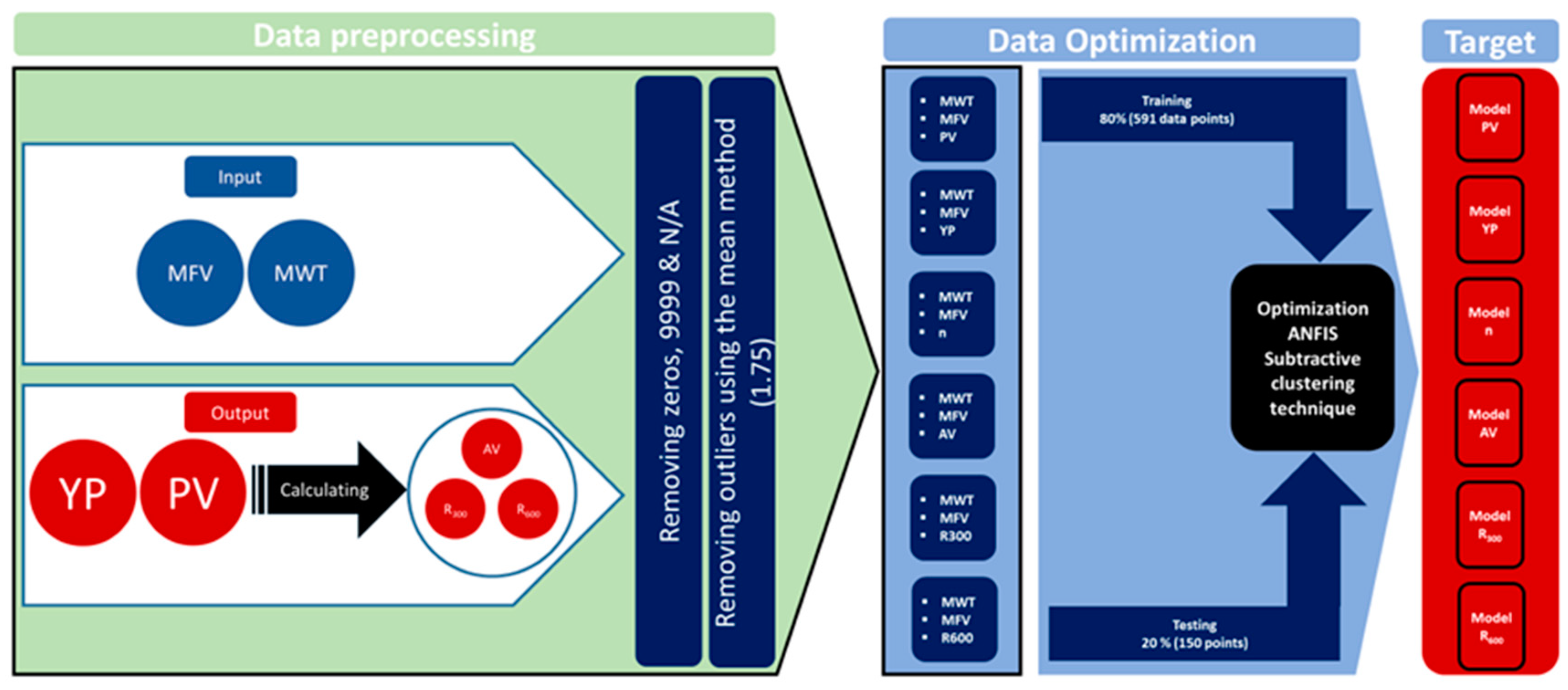
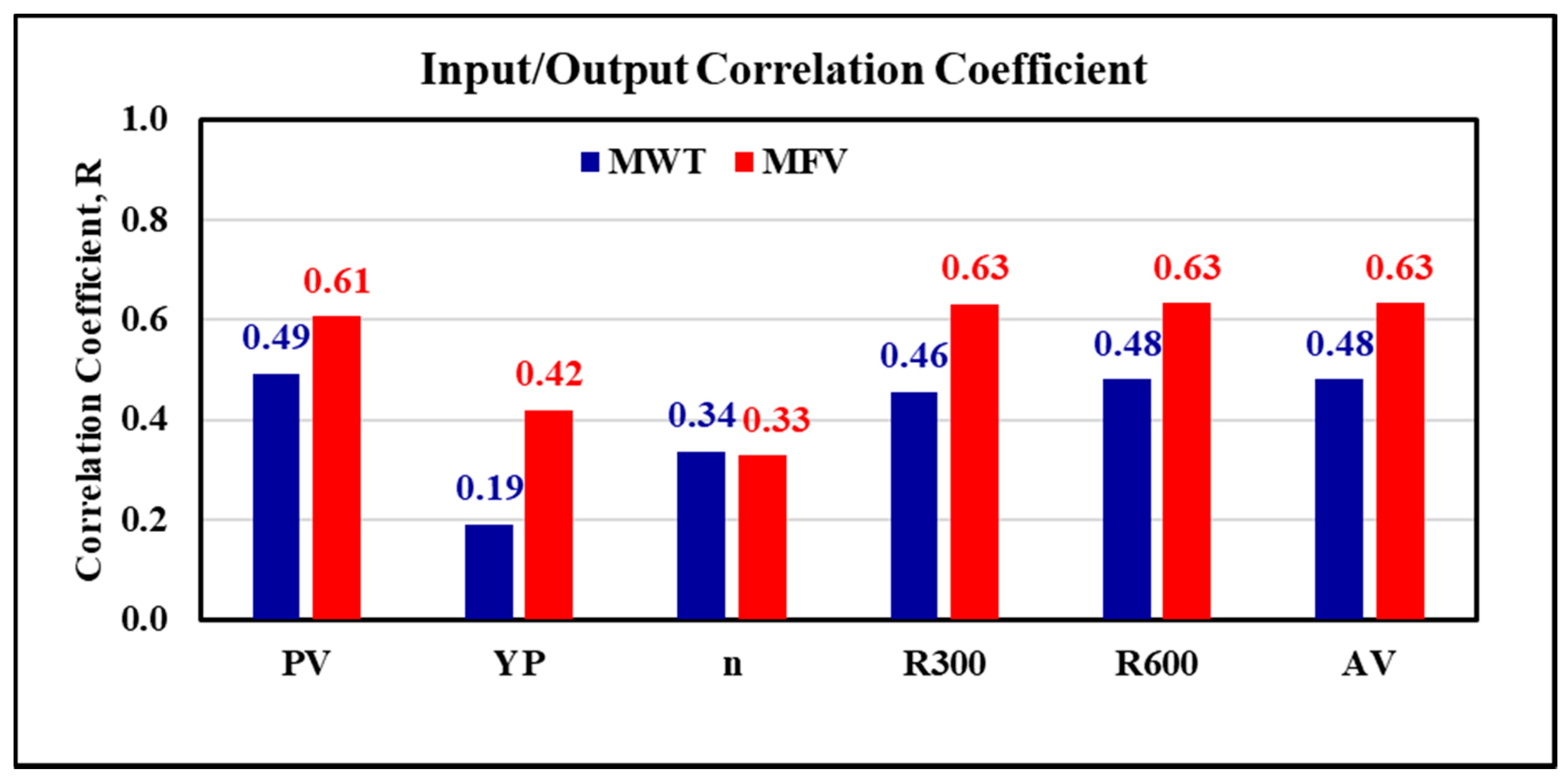

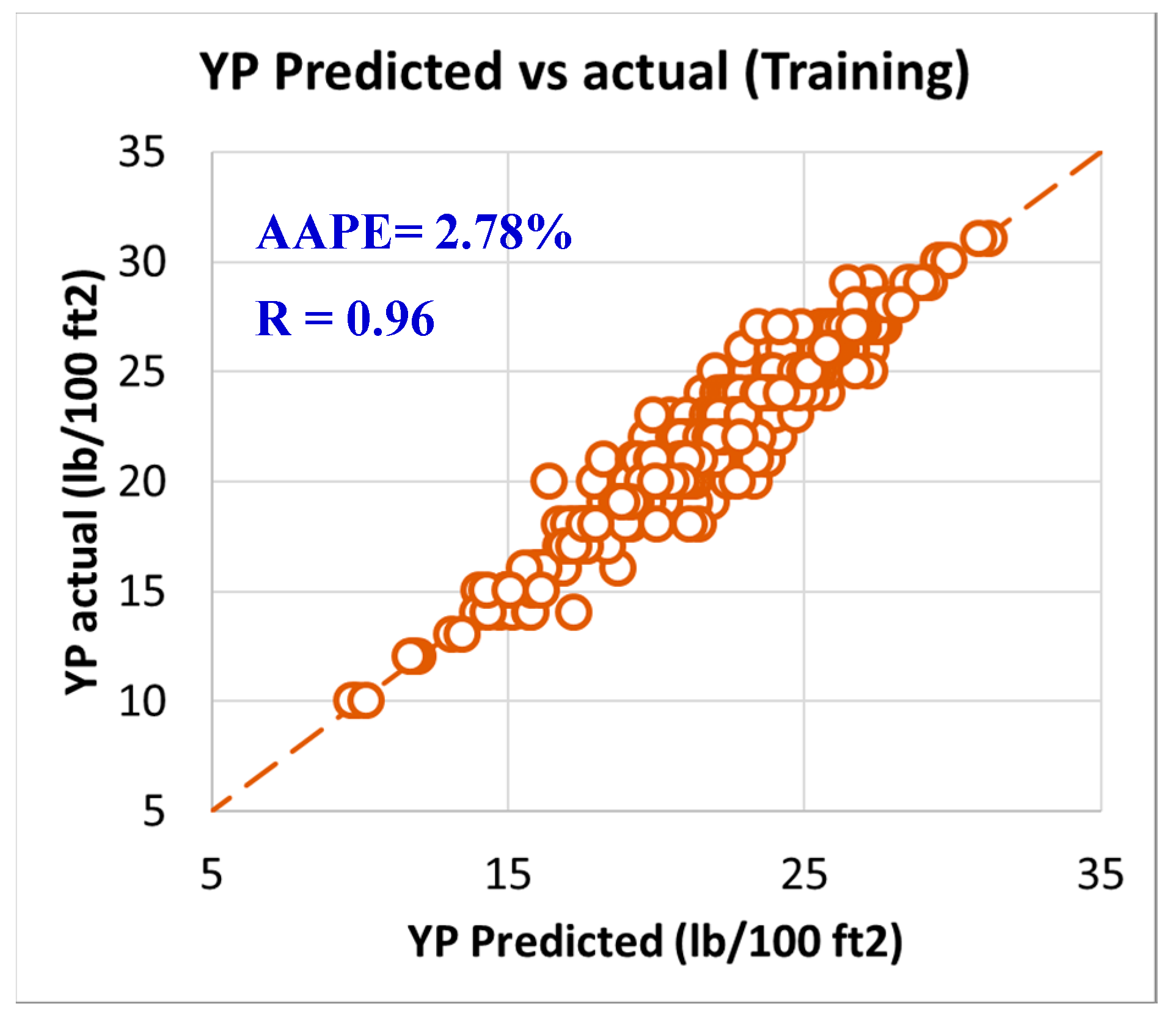
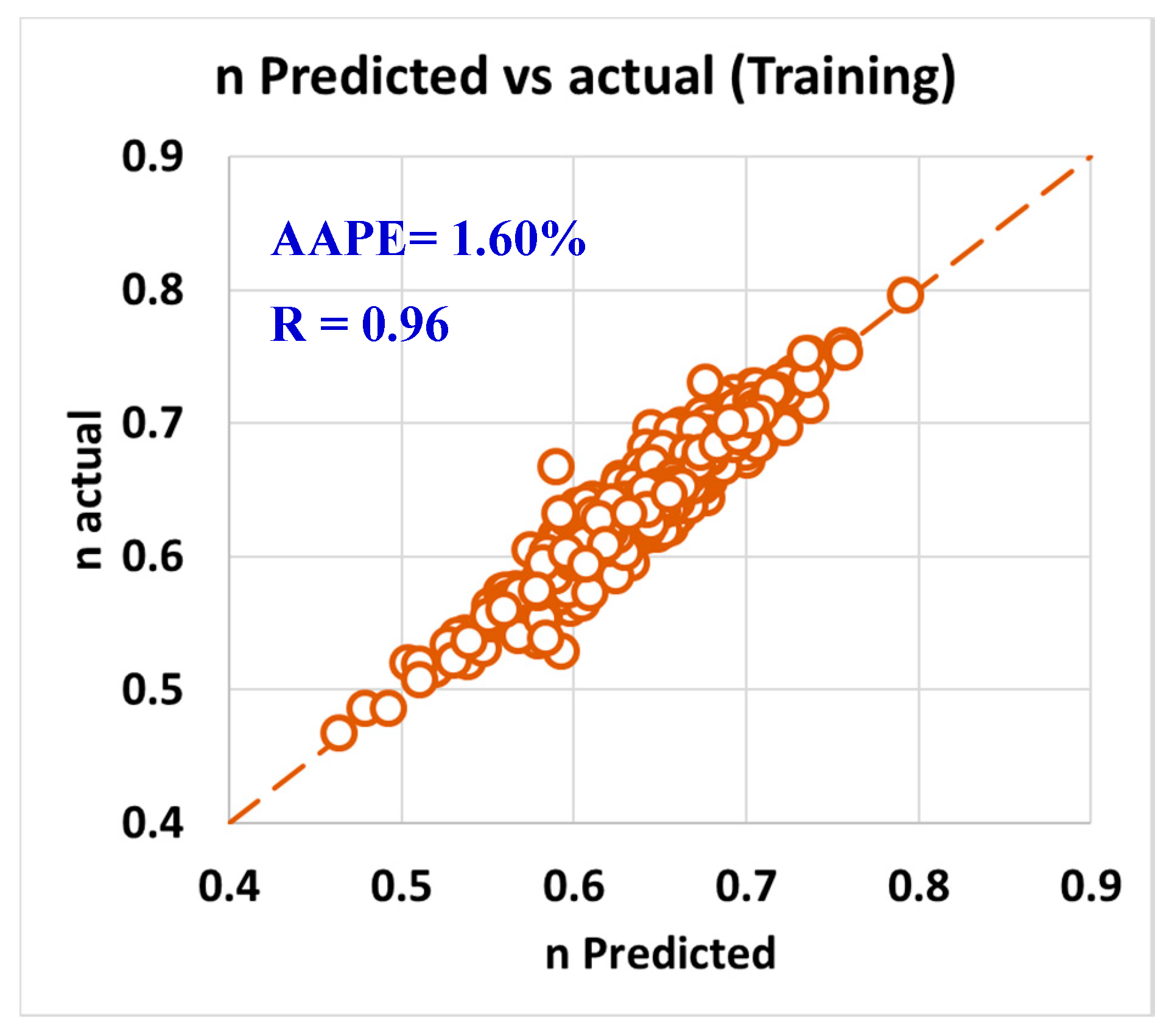



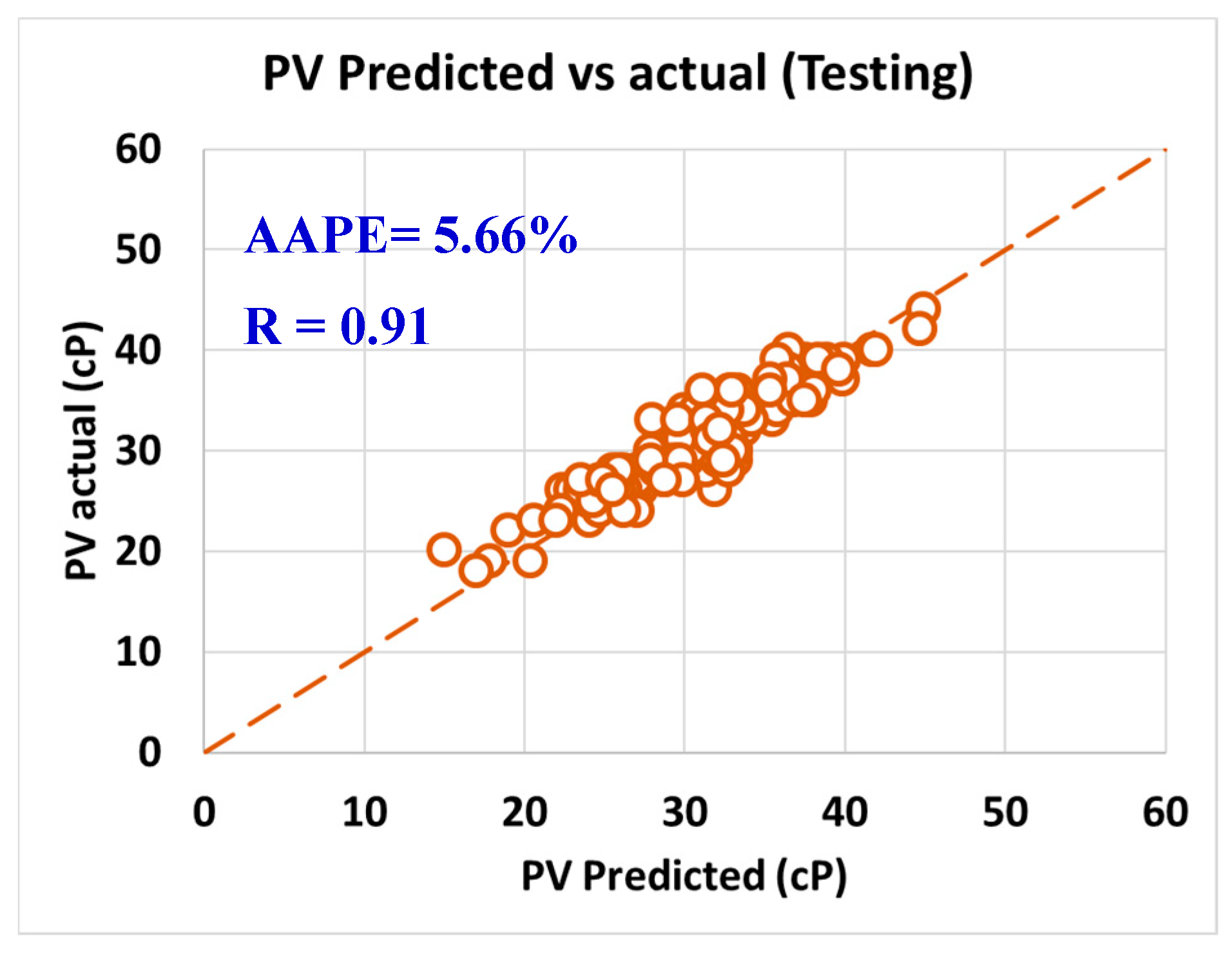
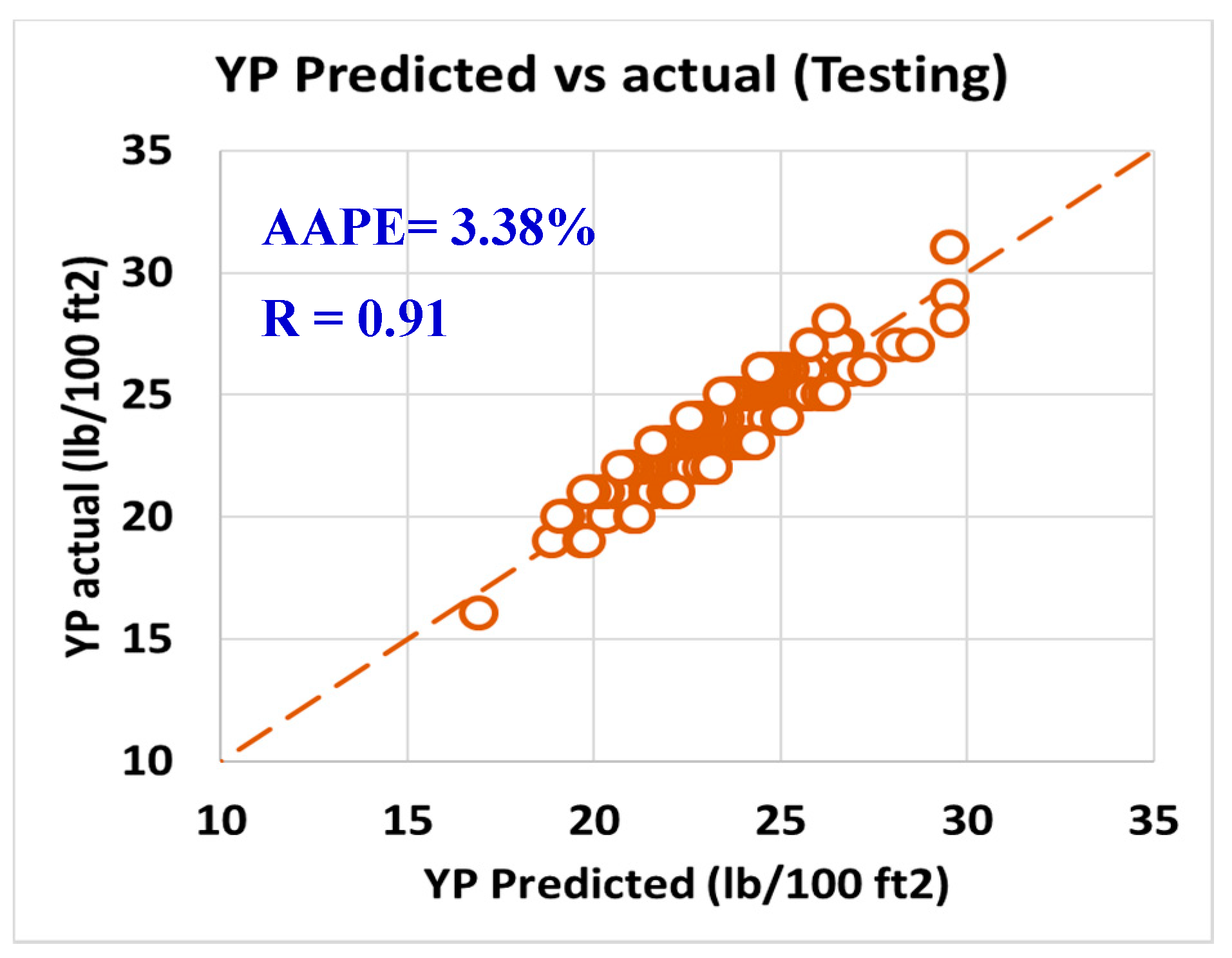
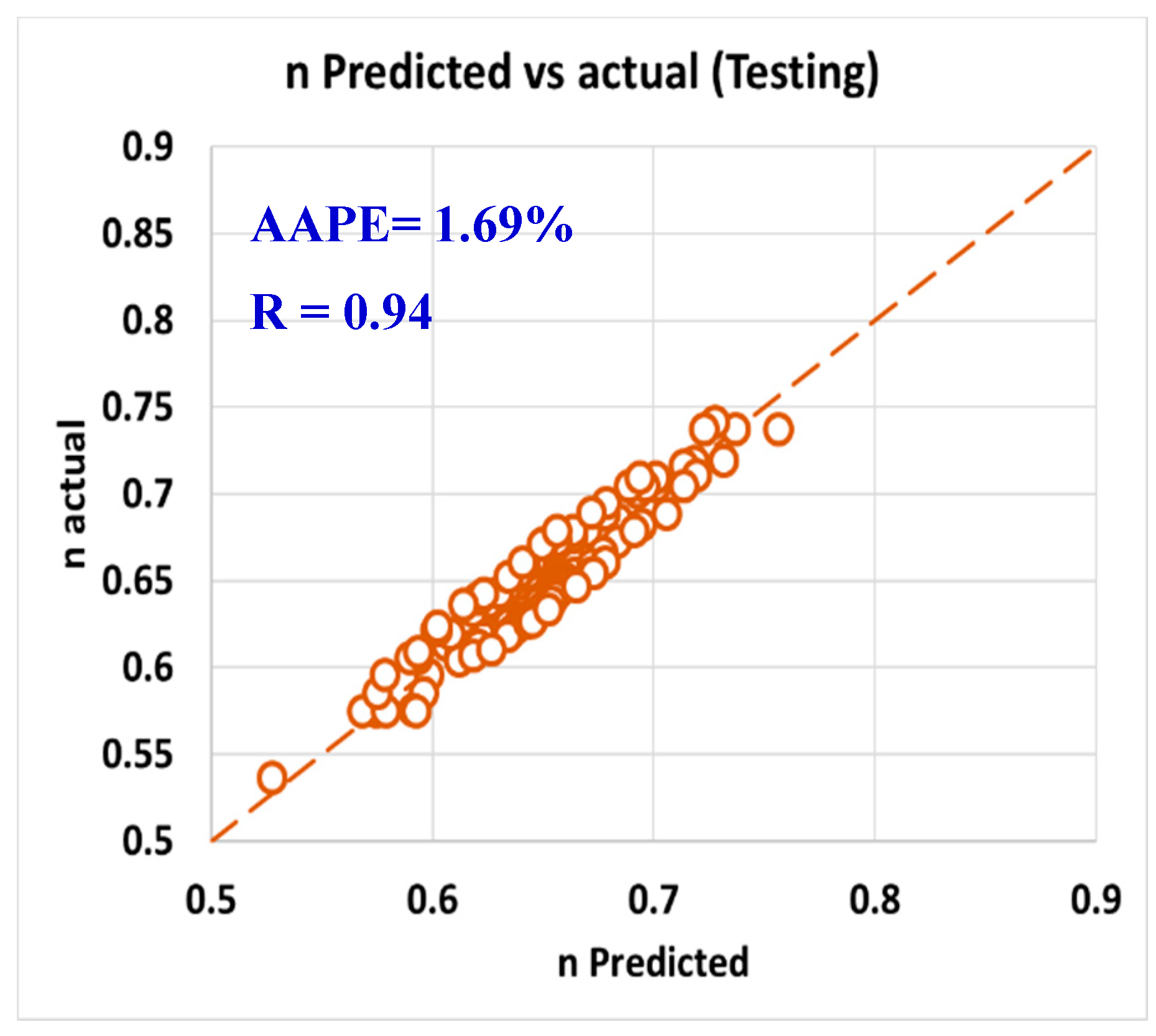
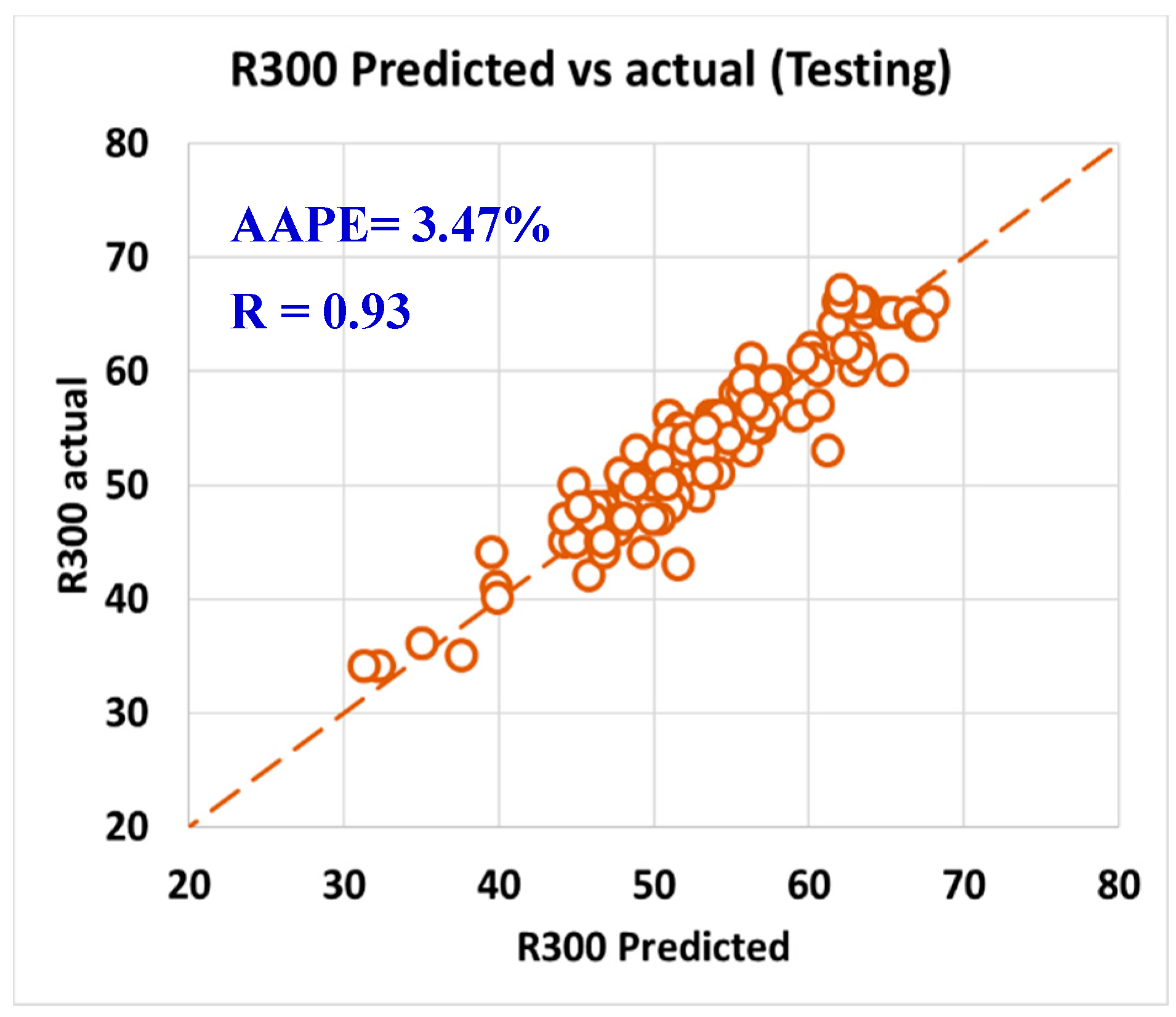
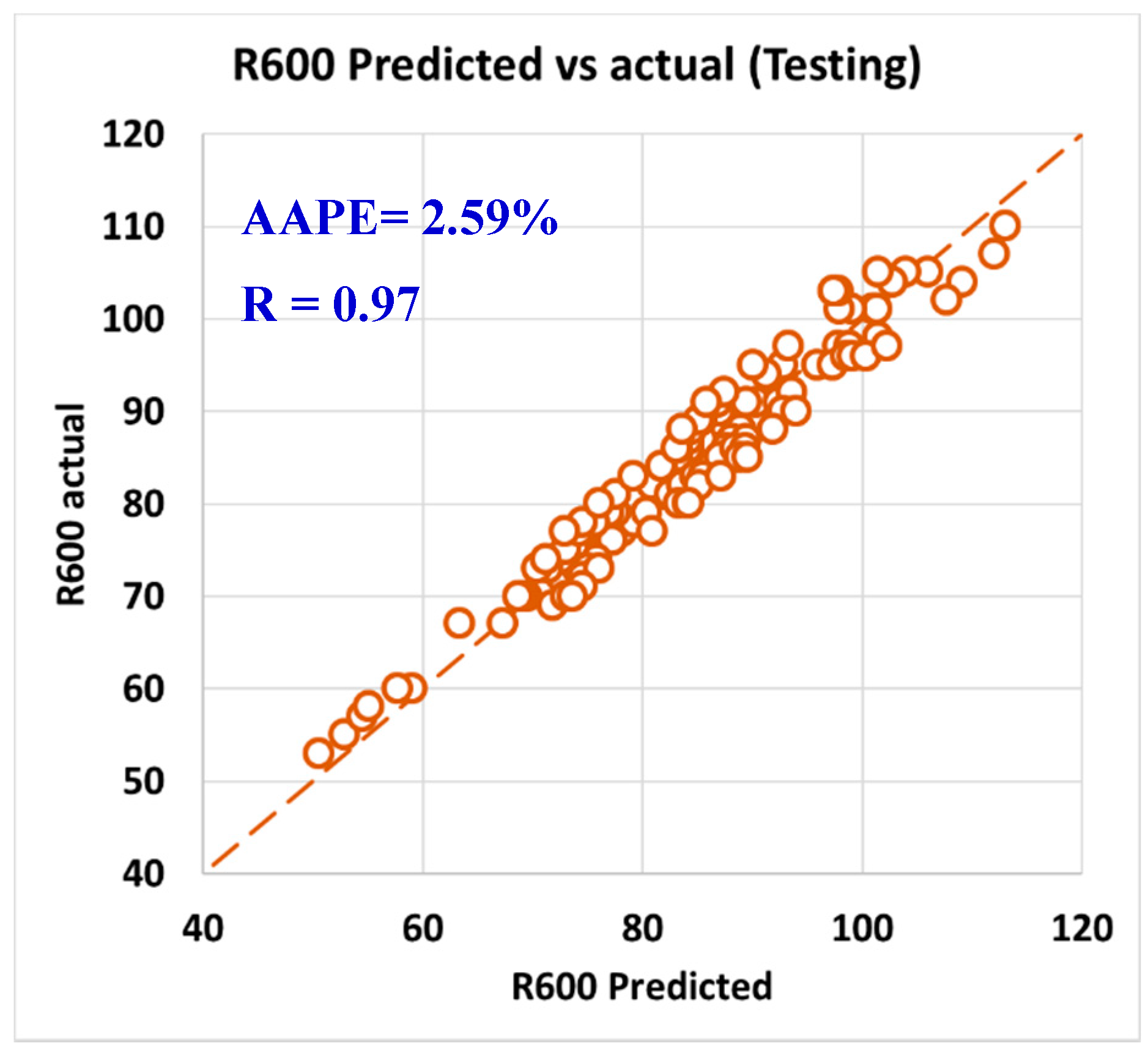

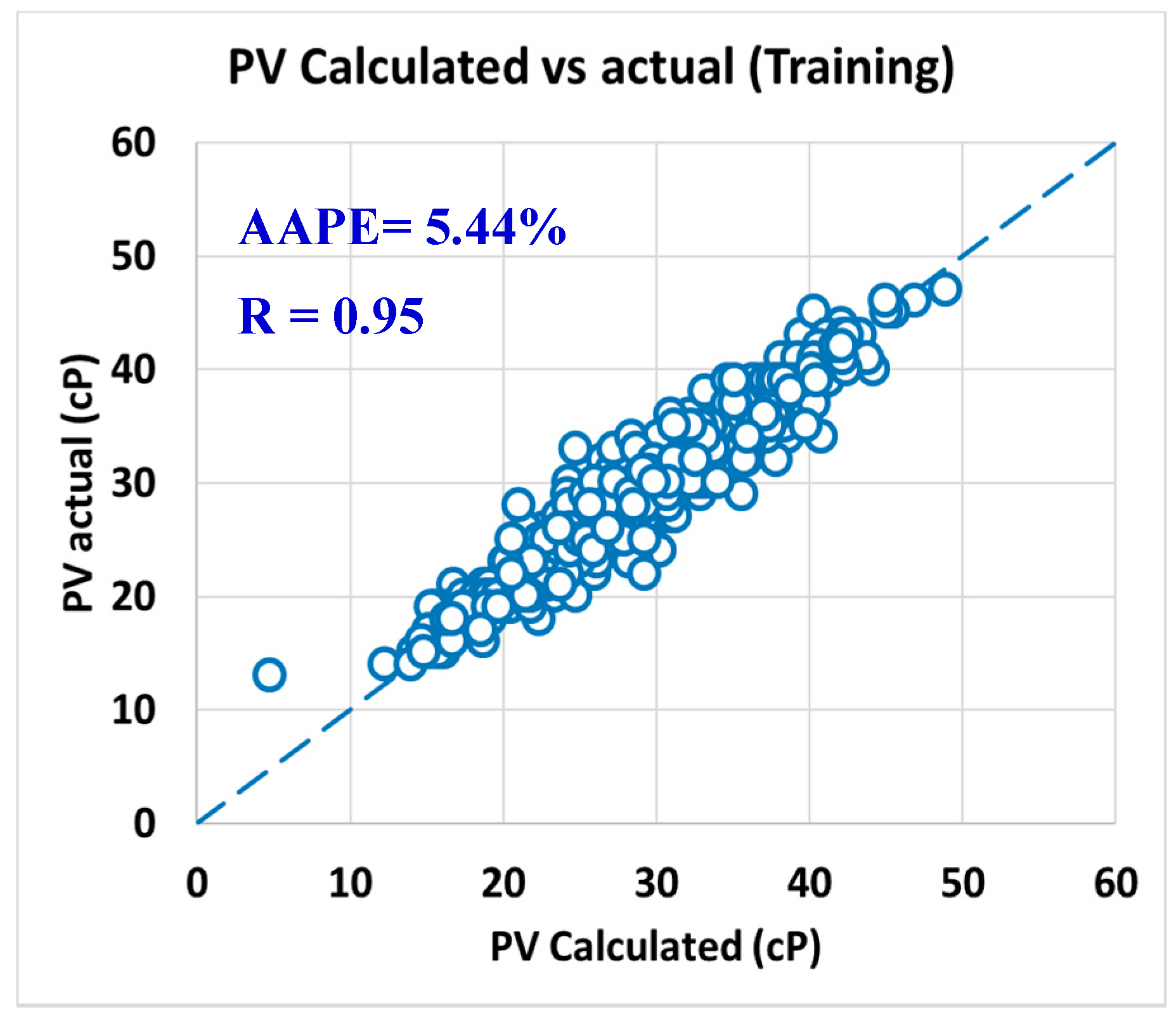

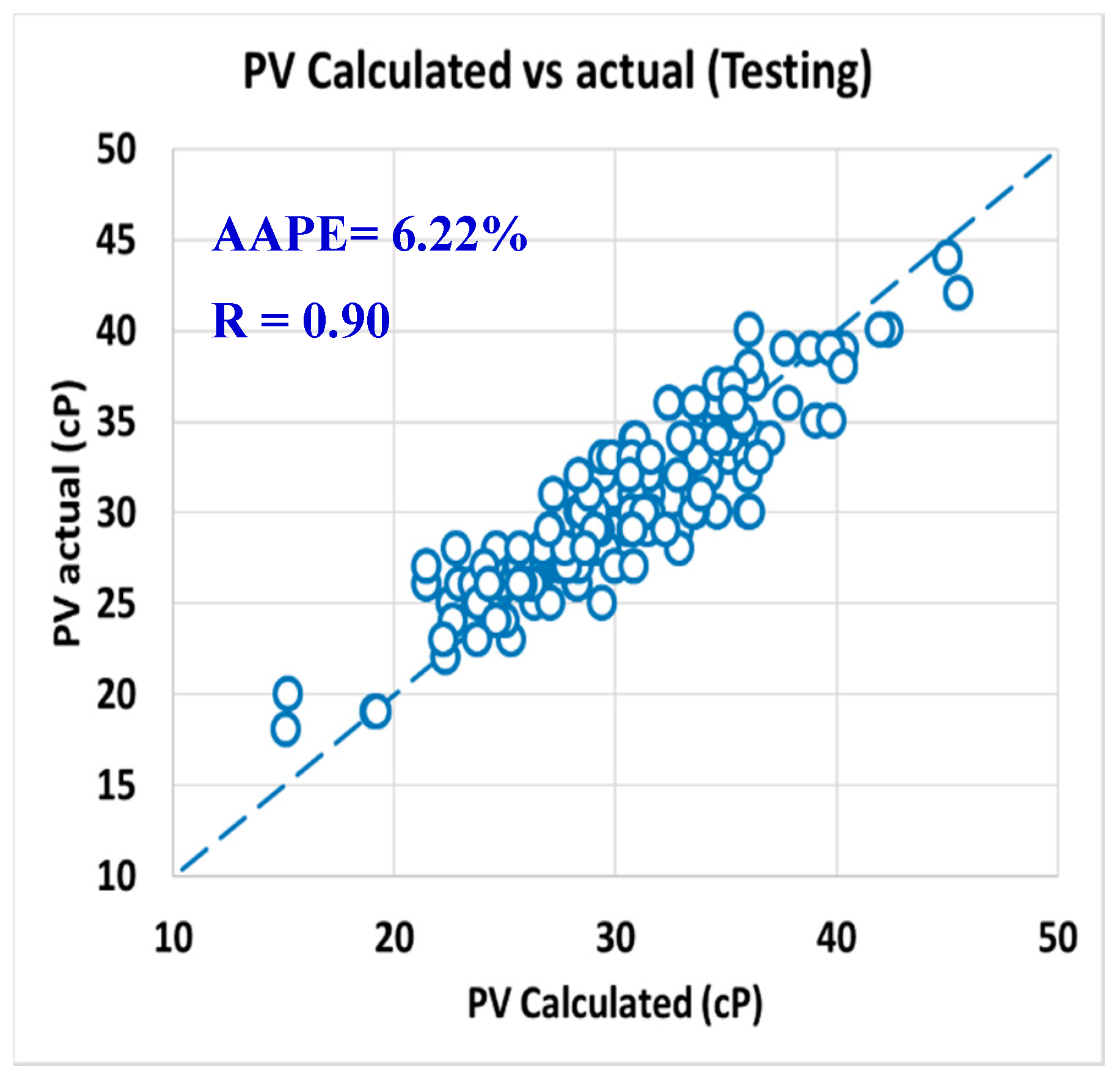

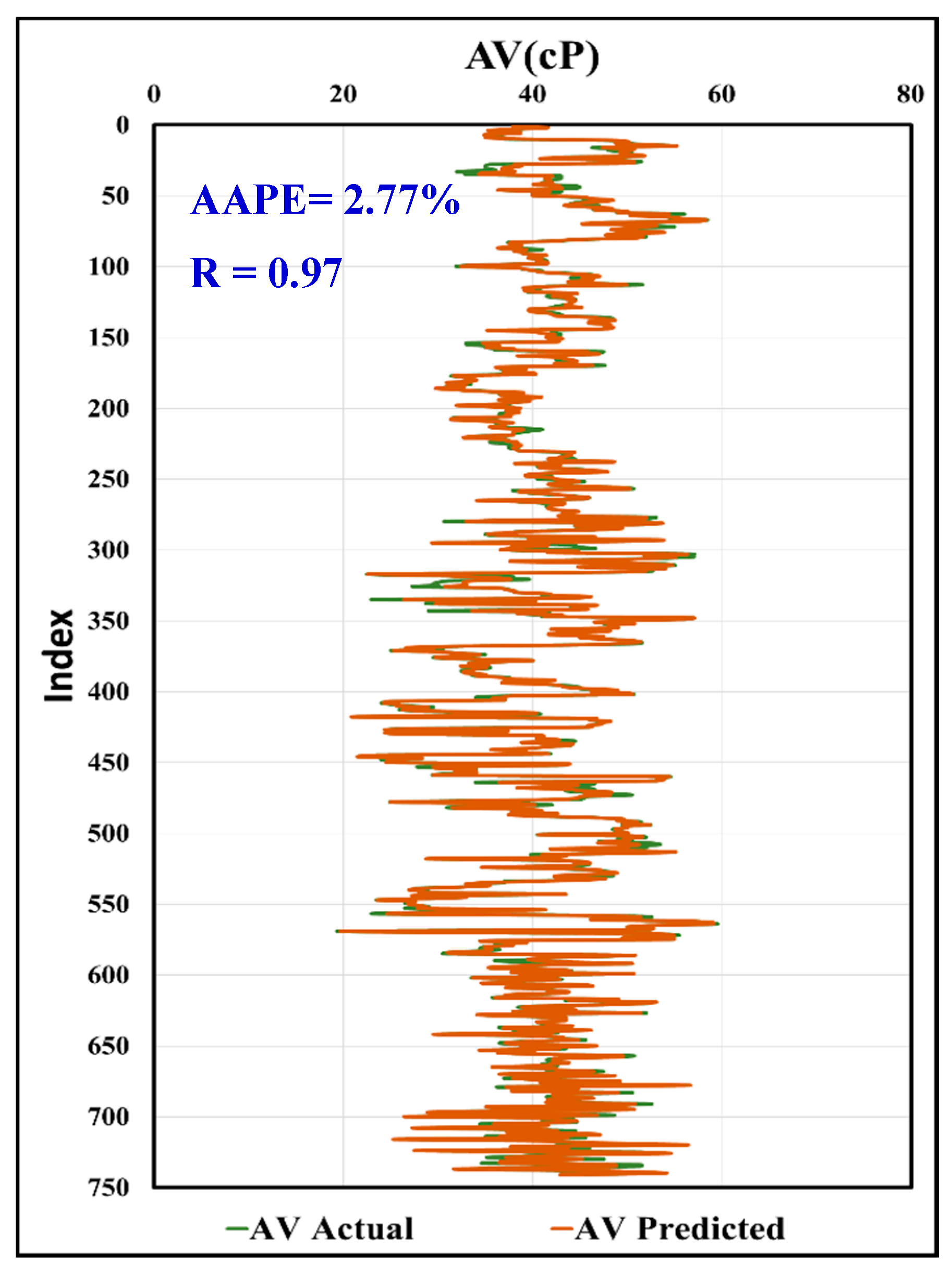
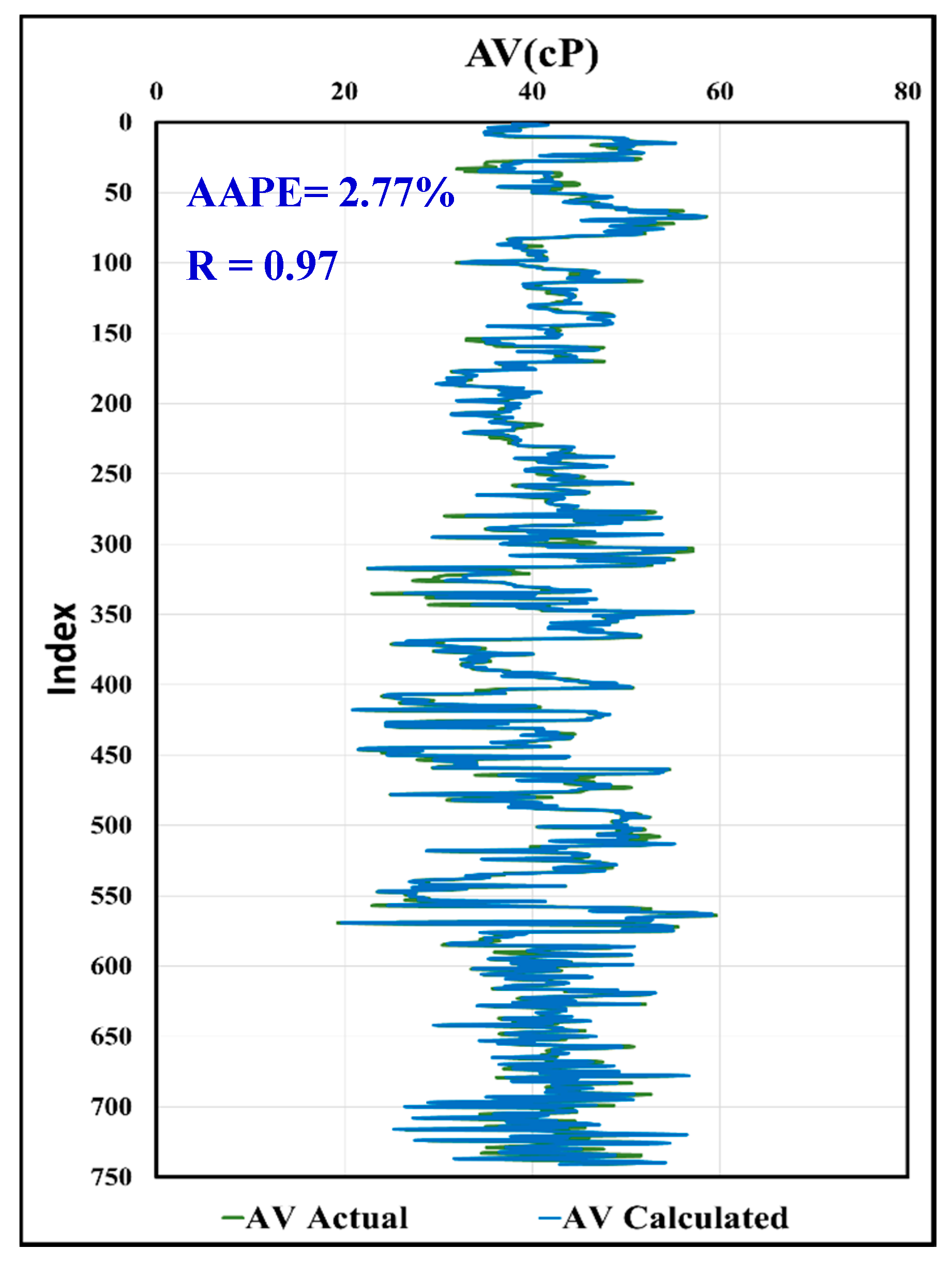

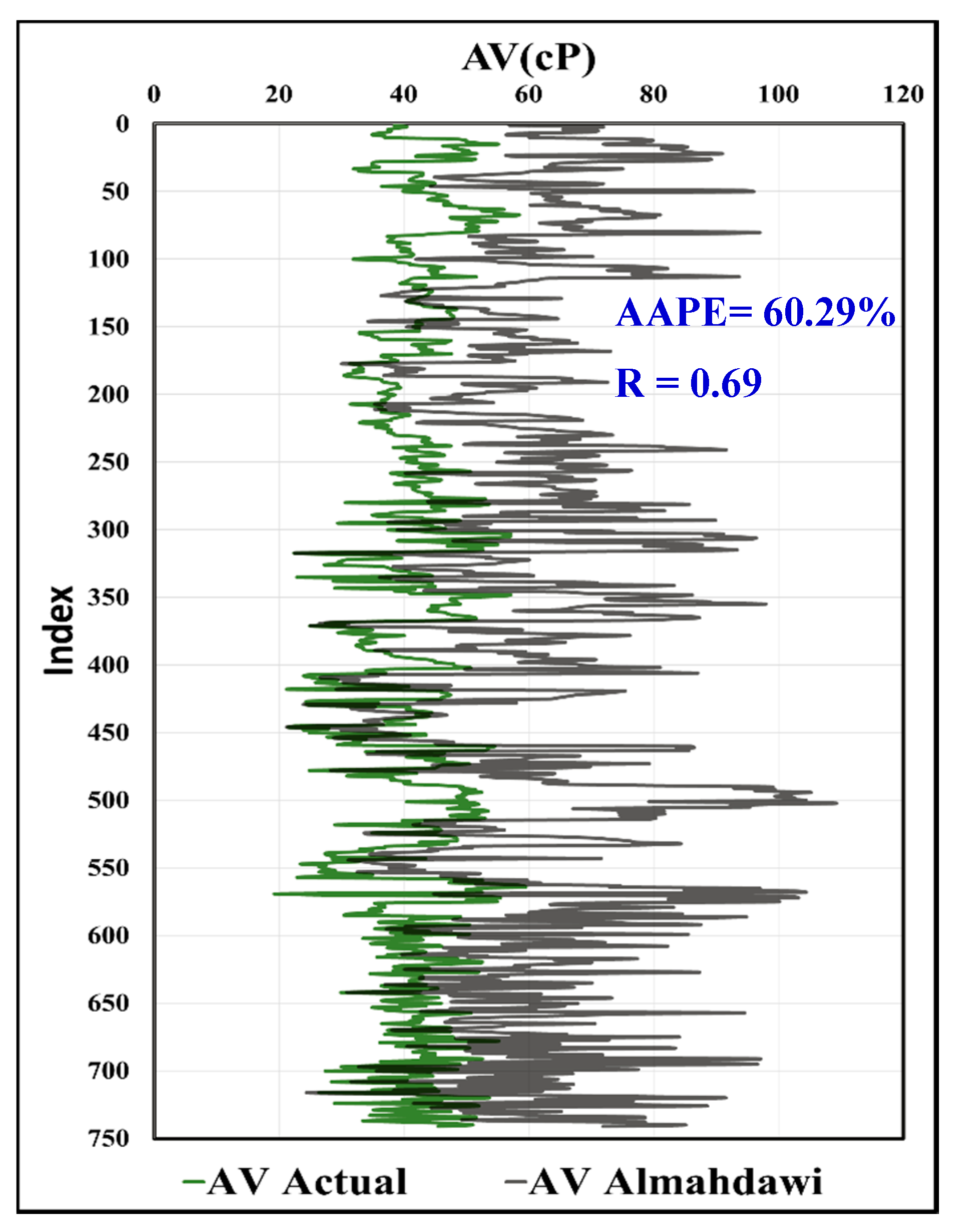
| MWT (PCF) | MFV (s) | PV (cP) | YP (lb/100 ft2) | The Behavior Index, n | R300 | R600 | AV (cP) | |
|---|---|---|---|---|---|---|---|---|
| Minimum | 67.00 | 45.00 | 13.00 | 10.00 | 0.47 | 25.00 | 40.00 | 20.00 |
| Maximum | 98.00 | 98.00 | 47.00 | 31.00 | 0.80 | 72.00 | 119.00 | 59.50 |
| Mean | 82.26 | 73.48 | 30.00 | 22.68 | 0.65 | 52.63 | 82.63 | 41.31 |
| Standard Deviation | 6.80 | 11.05 | 6.31 | 3.28 | 0.05 | 8.31 | 14.36 | 7.18 |
| Kurtosis | −0.86 | −0.55 | −0.24 | 1.14 | 0.42 | 0.14 | −0.10 | −0.10 |
| Skewness | 0.22 | 0.08 | −0.07 | −0.71 | −0.33 | −0.41 | −0.26 | −0.26 |
| Data Set | PV (cP) | YP (lb/100 ft2) | n | R300 | R600 | AV (cP) | |
|---|---|---|---|---|---|---|---|
| Training Data | Minimum | 13 | 10 | 0.47 | 25 | 40 | 20 |
| Maximum | 47 | 31 | 0.80 | 72 | 119 | 59.50 | |
| Testing Data | Minimum | 18 | 16 | 0.54 | 34 | 53 | 26.50 |
| Maximum | 44 | 31 | 0.74 | 67 | 110 | 55 | |
| AV (Pitt) | AV (Almahdawi) | AV Calculated from Predicted R600 | AV Predicted | |
|---|---|---|---|---|
| AAPE% | 64.24 | 60.29 | 2.77 | 2.77 |
| R | 0.69 | 0.69 | 0.97 | 0.97 |
© 2020 by the authors. Licensee MDPI, Basel, Switzerland. This article is an open access article distributed under the terms and conditions of the Creative Commons Attribution (CC BY) license (http://creativecommons.org/licenses/by/4.0/).
Share and Cite
Alsabaa, A.; Gamal, H.; Elkatatny, S.; Abdulraheem, A. Real-Time Prediction of Rheological Properties of Invert Emulsion Mud Using Adaptive Neuro-Fuzzy Inference System. Sensors 2020, 20, 1669. https://doi.org/10.3390/s20061669
Alsabaa A, Gamal H, Elkatatny S, Abdulraheem A. Real-Time Prediction of Rheological Properties of Invert Emulsion Mud Using Adaptive Neuro-Fuzzy Inference System. Sensors. 2020; 20(6):1669. https://doi.org/10.3390/s20061669
Chicago/Turabian StyleAlsabaa, Ahmed, Hany Gamal, Salaheldin Elkatatny, and Abdulazeez Abdulraheem. 2020. "Real-Time Prediction of Rheological Properties of Invert Emulsion Mud Using Adaptive Neuro-Fuzzy Inference System" Sensors 20, no. 6: 1669. https://doi.org/10.3390/s20061669
APA StyleAlsabaa, A., Gamal, H., Elkatatny, S., & Abdulraheem, A. (2020). Real-Time Prediction of Rheological Properties of Invert Emulsion Mud Using Adaptive Neuro-Fuzzy Inference System. Sensors, 20(6), 1669. https://doi.org/10.3390/s20061669






